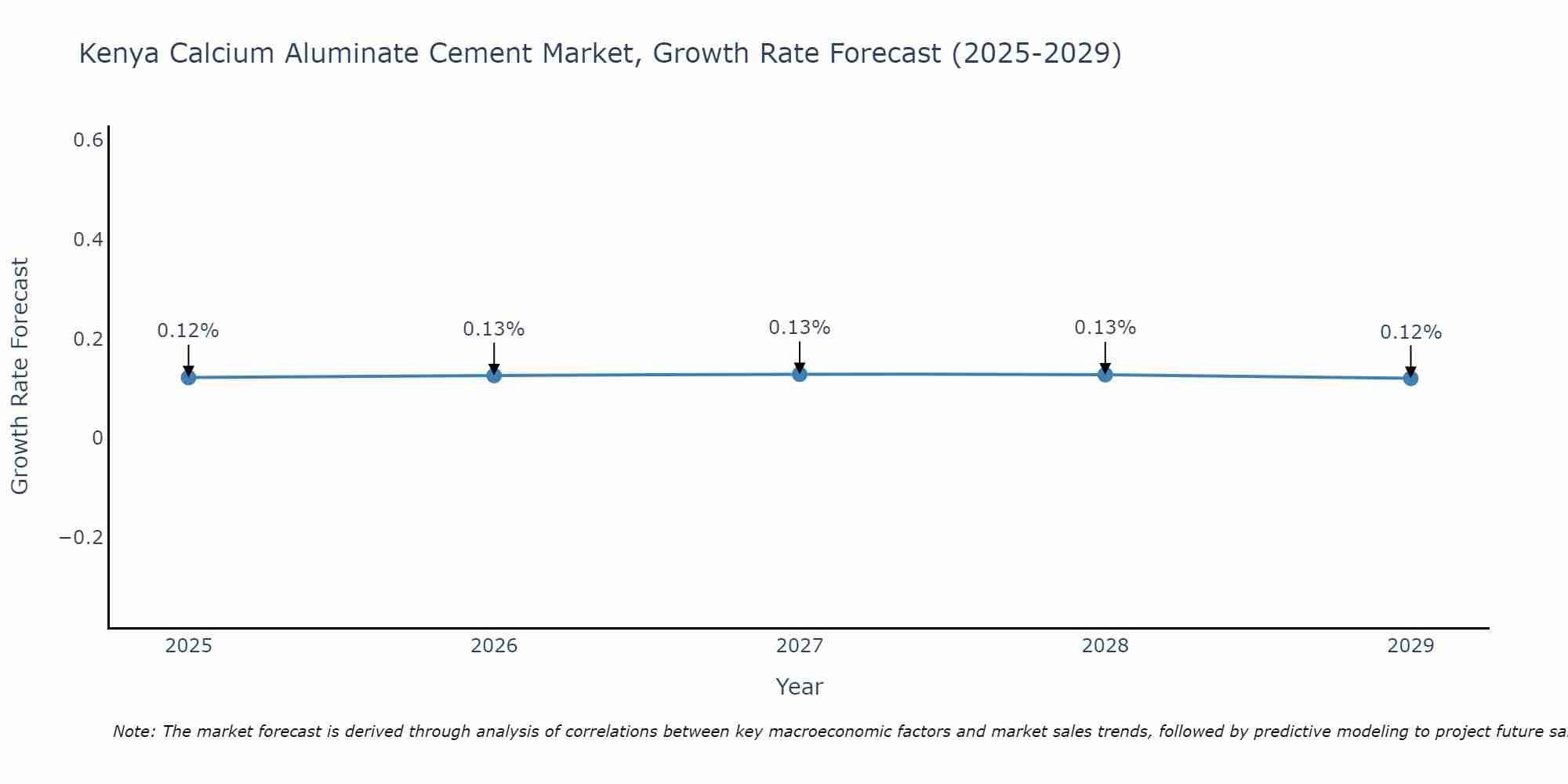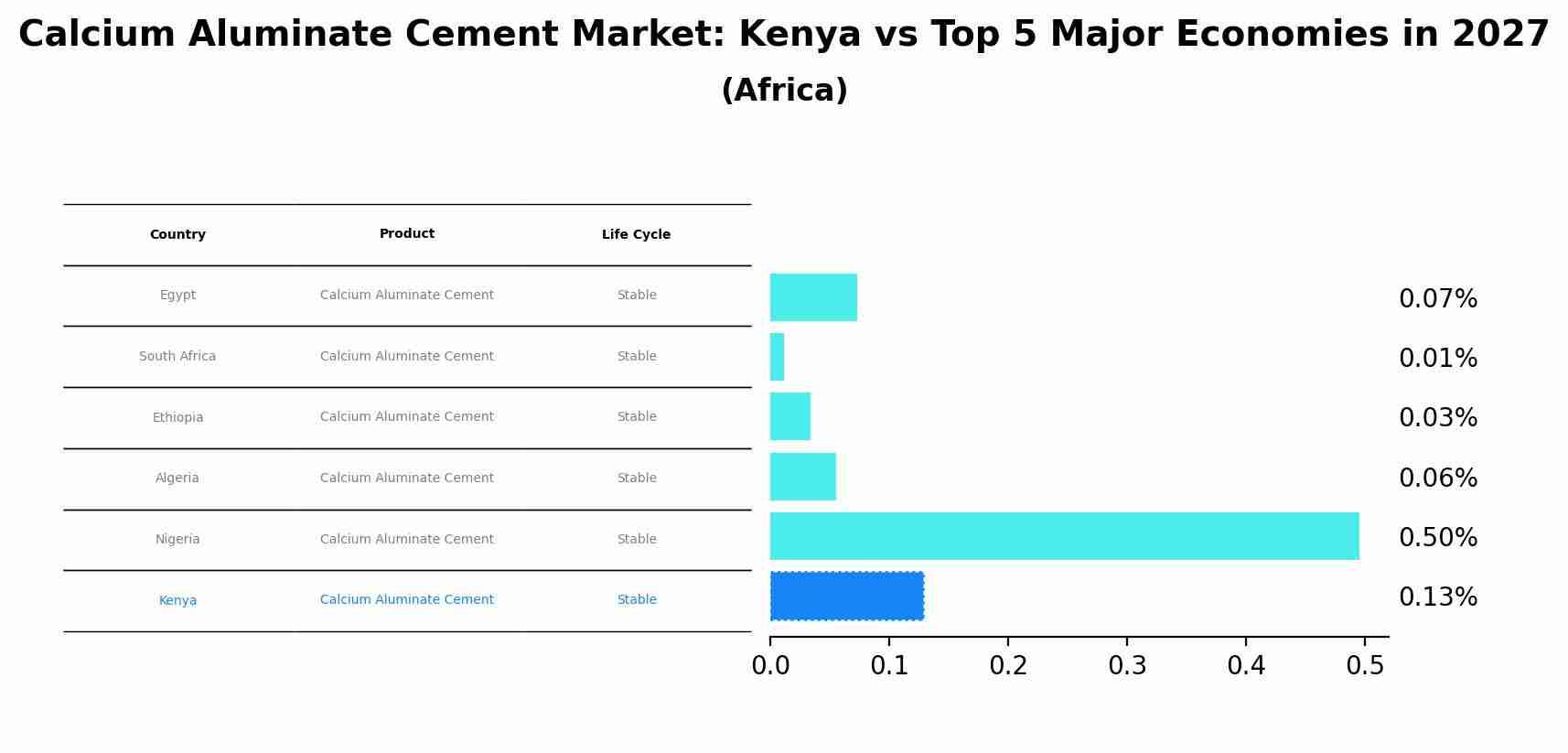Kenya Calcium Aluminate Cement Market (2025-2031) Outlook | Industry, Companies, Forecast, Size, Analysis, Revenue, Trends, Share, Value & Growth
| Product Code: ETC316730 | Publication Date: Aug 2022 | Updated Date: Jun 2025 | Product Type: Market Research Report | |
| Publisher: 6Wresearch | Author: Ravi Bhandari | No. of Pages: 75 | No. of Figures: 35 | No. of Tables: 20 |
Kenya Calcium Aluminate Cement Market Size Growth Rate
The Kenya Calcium Aluminate Cement Market is projected to witness mixed growth rate patterns during 2025 to 2029. Growth accelerates to 0.13% in 2027, following an initial rate of 0.12%, before easing to 0.12% at the end of the period.

Calcium Aluminate Cement Market: Kenya vs Top 5 Major Economies in 2027 (Africa)
The Calcium Aluminate Cement market in Kenya is projected to grow at a stable growth rate of 0.13% by 2027, highlighting the country's increasing focus on advanced technologies within the Africa region, where Egypt holds the dominant position, followed closely by South Africa, Ethiopia, Algeria and Nigeria, shaping overall regional demand.

Kenya Calcium Aluminate Cement Market Overview
The Kenya Calcium Aluminate Cement Market is experiencing steady growth driven by the expanding construction sector. Calcium aluminate cement offers high-performance properties such as rapid setting times, corrosion resistance, and durability, making it ideal for use in various construction applications including refractory castables, sewage systems, and high-temperature industrial installations. The market is witnessing increasing demand from infrastructure projects, commercial buildings, and residential construction. Key players in the market are focusing on product innovation, strategic partnerships, and expanding distribution networks to gain a competitive edge. Government initiatives to improve infrastructure and urban development projects are further fueling the growth of the calcium aluminate cement market in Kenya.
Kenya Calcium Aluminate Cement Market Trends
The Kenya Calcium Aluminate Cement market is witnessing a growing demand due to its superior properties such as high early strength, resistance to high temperatures, and durability. The construction industry in Kenya is driving this trend, with a focus on infrastructure development projects and the increasing use of precast concrete elements. Additionally, the rising awareness about the benefits of calcium aluminate cement, such as reduced construction time and enhanced performance in harsh environments, is fueling its adoption in various applications like industrial flooring, refractory linings, and sewage systems. Market players are also investing in research and development to introduce innovative products tailored to meet the specific needs of the local construction sector, further driving the growth of the Kenya Calcium Aluminate Cement market.
Kenya Calcium Aluminate Cement Market Challenges
In the Kenya Calcium Aluminate Cement Market, challenges include limited awareness and education among consumers and construction professionals regarding the benefits and applications of calcium aluminate cement compared to traditional cement. Additionally, the higher cost of calcium aluminate cement relative to conventional cement poses a barrier to its widespread adoption in the market. Supply chain issues, such as inconsistent availability and distribution of calcium aluminate cement products, further hinder market growth. Furthermore, the lack of standardized regulations and specifications specifically tailored to calcium aluminate cement in Kenya creates uncertainty and reluctance among stakeholders to use this specialized cement in construction projects. Overcoming these challenges will require targeted education campaigns, price competitiveness strategies, improved supply chain management, and collaborative efforts to establish clear industry guidelines and standards for calcium aluminate cement in the Kenyan market.
Kenya Calcium Aluminate Cement Market Investment Opportunities
In the Kenya Calcium Aluminate Cement Market, there are several investment opportunities that could be attractive to investors. With the growing construction industry in Kenya, there is a rising demand for high-performance construction materials like calcium aluminate cement, which offers superior strength and durability compared to traditional cement. Investing in the production or distribution of calcium aluminate cement in Kenya could be a lucrative opportunity for investors looking to capitalize on this growing market. Additionally, as there is a focus on infrastructure development and urbanization in Kenya, the demand for specialized construction materials is expected to increase, further bolstering the potential for investment in the calcium aluminate cement sector. Conducting a thorough market analysis and understanding the competitive landscape would be crucial for investors looking to seize these opportunities effectively.
Kenya Calcium Aluminate Cement Market Government Policy
Government policies related to the Kenya Calcium Aluminate Cement Market focus on promoting local production to reduce dependency on imports and enhance self-sufficiency. The government has implemented measures such as import tariffs and quality standards to encourage the use of locally manufactured calcium aluminate cement. Additionally, there are initiatives to support research and development in the sector to improve product quality and competitiveness in the global market. The government aims to create a conducive environment for domestic manufacturers to thrive and contribute to economic growth while ensuring that consumers have access to high-quality calcium aluminate cement for construction purposes.
Kenya Calcium Aluminate Cement Market Future Outlook
The future outlook for the Kenya Calcium Aluminate Cement Market appears promising, driven by increasing infrastructure development projects, urbanization, and the growing construction industry in the country. Calcium aluminate cement is gaining popularity due to its superior properties such as rapid setting and high temperature resistance, making it suitable for various applications including industrial furnaces, refractory linings, and sewage treatment plants. As Kenya continues to invest in infrastructure and construction projects, the demand for calcium aluminate cement is expected to rise. Additionally, the government`s focus on sustainable development and environmental regulations may further boost the market as calcium aluminate cement is known for its eco-friendly characteristics. Overall, the Kenya Calcium Aluminate Cement Market is likely to witness steady growth in the coming years.
Key Highlights of the Report:
- Kenya Calcium Aluminate Cement Market Outlook
- Market Size of Kenya Calcium Aluminate Cement Market, 2024
- Forecast of Kenya Calcium Aluminate Cement Market, 2031
- Historical Data and Forecast of Kenya Calcium Aluminate Cement Revenues & Volume for the Period 2021 - 2031
- Kenya Calcium Aluminate Cement Market Trend Evolution
- Kenya Calcium Aluminate Cement Market Drivers and Challenges
- Kenya Calcium Aluminate Cement Price Trends
- Kenya Calcium Aluminate Cement Porter's Five Forces
- Kenya Calcium Aluminate Cement Industry Life Cycle
- Historical Data and Forecast of Kenya Calcium Aluminate Cement Market Revenues & Volume By Product for the Period 2021 - 2031
- Historical Data and Forecast of Kenya Calcium Aluminate Cement Market Revenues & Volume By CAC 40 for the Period 2021 - 2031
- Historical Data and Forecast of Kenya Calcium Aluminate Cement Market Revenues & Volume By CAC 50 for the Period 2021 - 2031
- Historical Data and Forecast of Kenya Calcium Aluminate Cement Market Revenues & Volume By CAC 60 for the Period 2021 - 2031
- Historical Data and Forecast of Kenya Calcium Aluminate Cement Market Revenues & Volume By CAC 70-80 for the Period 2021 - 2031
- Kenya Calcium Aluminate Cement Import Export Trade Statistics
- Market Opportunity Assessment By Product
- Kenya Calcium Aluminate Cement Top Companies Market Share
- Kenya Calcium Aluminate Cement Competitive Benchmarking By Technical and Operational Parameters
- Kenya Calcium Aluminate Cement Company Profiles
- Kenya Calcium Aluminate Cement Key Strategic Recommendations
Frequently Asked Questions About the Market Study (FAQs):
1 Executive Summary |
2 Introduction |
2.1 Key Highlights of the Report |
2.2 Report Description |
2.3 Market Scope & Segmentation |
2.4 Research Methodology |
2.5 Assumptions |
3 Kenya Calcium Aluminate Cement Market Overview |
3.1 Kenya Country Macro Economic Indicators |
3.2 Kenya Calcium Aluminate Cement Market Revenues & Volume, 2021 & 2031F |
3.3 Kenya Calcium Aluminate Cement Market - Industry Life Cycle |
3.4 Kenya Calcium Aluminate Cement Market - Porter's Five Forces |
3.5 Kenya Calcium Aluminate Cement Market Revenues & Volume Share, By Product, 2021 & 2031F |
4 Kenya Calcium Aluminate Cement Market Dynamics |
4.1 Impact Analysis |
4.2 Market Drivers |
4.3 Market Restraints |
5 Kenya Calcium Aluminate Cement Market Trends |
6 Kenya Calcium Aluminate Cement Market, By Types |
6.1 Kenya Calcium Aluminate Cement Market, By Product |
6.1.1 Overview and Analysis |
6.1.2 Kenya Calcium Aluminate Cement Market Revenues & Volume, By Product, 2021 - 2031F |
6.1.3 Kenya Calcium Aluminate Cement Market Revenues & Volume, By CAC 40, 2021 - 2031F |
6.1.4 Kenya Calcium Aluminate Cement Market Revenues & Volume, By CAC 50, 2021 - 2031F |
6.1.5 Kenya Calcium Aluminate Cement Market Revenues & Volume, By CAC 60, 2021 - 2031F |
6.1.6 Kenya Calcium Aluminate Cement Market Revenues & Volume, By CAC 70-80, 2021 - 2031F |
7 Kenya Calcium Aluminate Cement Market Import-Export Trade Statistics |
7.1 Kenya Calcium Aluminate Cement Market Export to Major Countries |
7.2 Kenya Calcium Aluminate Cement Market Imports from Major Countries |
8 Kenya Calcium Aluminate Cement Market Key Performance Indicators |
9 Kenya Calcium Aluminate Cement Market - Opportunity Assessment |
9.1 Kenya Calcium Aluminate Cement Market Opportunity Assessment, By Product, 2021 & 2031F |
10 Kenya Calcium Aluminate Cement Market - Competitive Landscape |
10.1 Kenya Calcium Aluminate Cement Market Revenue Share, By Companies, 2024 |
10.2 Kenya Calcium Aluminate Cement Market Competitive Benchmarking, By Operating and Technical Parameters |
11 Company Profiles |
12 Recommendations |
13 Disclaimer |
- Single User License$ 1,995
- Department License$ 2,400
- Site License$ 3,120
- Global License$ 3,795
Search
Related Reports
- Portugal Occupational Health & Safety Services Market (2025-2031) | Strategy, Consumer Insights, Analysis, Investment Trends, Opportunities, Growth, Size, Share, Industry, Revenue, Segments, Value, Segmentation, Supply, Forecast, Restraints, Outlook, Competition, Drivers, Trends, Demand, Pricing Analysis, Competitive, Strategic Insights, Companies, Challenges
- Netherlands Occupational Health and Safety Services Market (2025-2031) | Strategy, Consumer Insights, Analysis, Investment Trends, Opportunities, Growth, Size, Share, Industry, Revenue, Segments, Value, Segmentation, Supply, Forecast, Restraints, Outlook, Competition, Drivers, Trends, Demand, Pricing Analysis, Competitive, Strategic Insights, Companies, Challenges
- Belgium and Luxembourg Facility Management Market (2025-2031) | Strategy, Consumer Insights, Analysis, Investment Trends, Opportunities, Growth, Size, Share, Industry, Revenue, Segments, Value, Segmentation, Supply, Forecast, Restraints, Outlook, Competition, Drivers, Trends, Demand, Pricing Analysis, Competitive, Strategic Insights, Companies, Challenges
- Russia Women Intimate Apparel Market (2025-2031) | Strategy, Consumer Insights, Analysis, Investment Trends, Opportunities, Growth, Size, Share, Industry, Revenue, Segments, Value, Segmentation, Supply, Forecast, Restraints, Outlook, Competition, Drivers, Trends, Demand, Pricing Analysis, Competitive, Strategic Insights, Companies, Challenges
- Africa Chocolate Market (2025-2031) | Size, Share, Trends, Growth, Revenue, Analysis, Forecast, industry & Outlook
- Global Hydroxychloroquine And Chloroquine Market (2025-2031) | Industry, Trends, Size, Outlook, Growth, Value, Companies, Revenue, Analysis, Share, Forecast
- Saudi Arabia Plant Maintenance Market (2025-2031) | Industry, Size, Growth, Revenue, Value, Companies, Forecast, Analysis, Share & Trends
- Taiwan Electric Truck Market (2025-2031) | Outlook, Industry, Revenue, Size, Forecast, Growth, Analysis, Share, Companies, Value & Trends
- South Korea Electric Bus Market (2025-2031) | Outlook, Industry, Companies, Analysis, Size, Revenue, Value, Forecast, Trends, Growth & Share
- Africa Low Temperature Powder Coating Market (2025-2031) | Companies, Competition, Size, Challenges, Segmentation, Trends, Competitive, Industry, Supply, Strategy, Investment Trends, Growth, Segments, Restraints, Strategic Insights, Revenue, Share, Forecast, Drivers, Analysis, Pricing Analysis, Demand, Consumer Insights, Value, Opportunities, Outlook
Industry Events and Analyst Meet
Our Clients
Whitepaper
- Middle East & Africa Commercial Security Market Click here to view more.
- Middle East & Africa Fire Safety Systems & Equipment Market Click here to view more.
- GCC Drone Market Click here to view more.
- Middle East Lighting Fixture Market Click here to view more.
- GCC Physical & Perimeter Security Market Click here to view more.
6WResearch In News
- Doha a strategic location for EV manufacturing hub: IPA Qatar
- Demand for luxury TVs surging in the GCC, says Samsung
- Empowering Growth: The Thriving Journey of Bangladesh’s Cable Industry
- Demand for luxury TVs surging in the GCC, says Samsung
- Video call with a traditional healer? Once unthinkable, it’s now common in South Africa
- Intelligent Buildings To Smooth GCC’s Path To Net Zero













